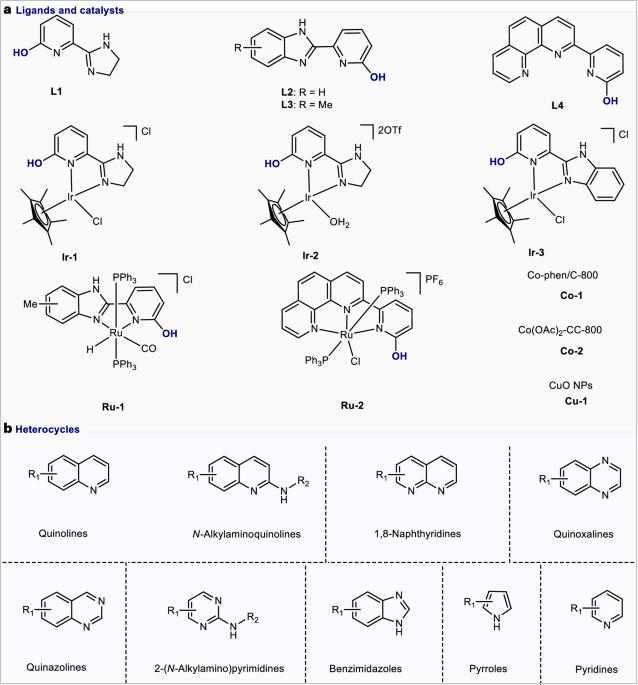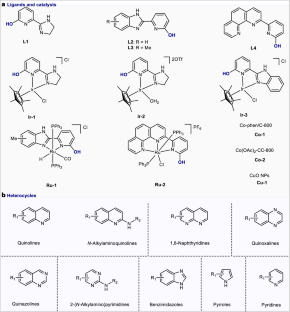Synthesis of N-heterocycles through alcohol dehydrogenative coupling
IF 13.1
1区 生物学
Q1 BIOCHEMICAL RESEARCH METHODS
引用次数: 0
Abstract
Nitrogen heterocycles are found in the structures of many biologically important compounds, as well as materials used in the synthesis of fine chemicals. Notably, ~59% of US Food and Drug Administration-approved small-molecule drugs contain nitrogen heterocycles. It is therefore meaningful to explore greener or more sustainable methods for their synthesis. The use of alcohols as reagents is attractive as they can be readily obtained from biomass derived natural resources. In the last two decades, alcohol dehydrogenative coupling reaction to synthesize various heterocycles were extensively explored which furnished hydrogen (H2) and water (H2O) as the two greener byproducts. In this protocol, we describe several efficient catalytic transformations to synthesize quinolines, 1,8-naphthyridines, quinoxalines, quinazolines, pyrimidines, benzimidazoles, pyrroles and pyridines, using alcohol as starting materials. We also describe the synthesis of several homogeneous iridium/ruthenium catalysts and heterogeneous cobalt/copper catalysts that can be used in these transformations. The reaction setup is simple; in a Schlenk/reaction tube with magnetic stir-bar, alcohol, corresponding coupling reagents (nucleophiles), catalyst, base and solvent (water or organic solvent such as toluene, dioxane or p-xylene) are added. The reaction mixture is refluxed at the specified temperature (110–150 °C)—either in air or under argon—to furnish these heterocycles. Synthesis of the catalysts takes 3–5 h and the coupling reactions take 4–5 h depending on the target product. The cobalt- and copper-based heterogeneous catalytic systems displayed an good catalyst recyclability. Nitrogen heterocycles are a large class of chemically and biologically relevant compounds. This protocol describes their synthesis from alcohols using homogeneous iridium/ruthenium catalysts and heterogeneous cobalt/copper catalysts.


通过醇脱氢偶联合成 N-杂环。
氮杂环存在于许多具有重要生物学意义的化合物结构中,也存在于用于合成精细化学品的材料中。值得注意的是,美国食品和药物管理局批准的小分子药物中约有 59% 含有氮杂环。因此,探索更环保或更可持续的方法来合成氮杂环具有重要意义。使用醇类作为试剂很有吸引力,因为它们很容易从生物质自然资源中获得。在过去二十年中,人们广泛探索了合成各种杂环的醇脱氢偶联反应,该反应产生的氢气(H2)和水(H2O)是两种更环保的副产品。在本规程中,我们介绍了以醇为起始原料合成喹啉类、1,8-萘啶类、喹喔啉类、喹唑啉类、嘧啶类、苯并咪唑类、吡咯类和吡啶类化合物的几种高效催化转化方法。我们还介绍了几种可用于这些转化的均相铱/钌催化剂和异相钴/铜催化剂的合成方法。反应装置非常简单:在带有磁力搅拌棒的施伦克/反应管中加入酒精、相应的偶联试剂(亲核剂)、催化剂、碱和溶剂(水或有机溶剂,如甲苯、二噁烷或对二甲苯)。反应混合物在指定温度(110-150 °C)下(空气中或氩气中)回流,生成这些杂环。根据目标产物的不同,催化剂的合成需要 3-5 小时,偶联反应需要 4-5 小时。钴基和铜基异相催化体系显示出良好的催化剂可回收性。
本文章由计算机程序翻译,如有差异,请以英文原文为准。
求助全文
约1分钟内获得全文
求助全文
来源期刊

Nature Protocols
生物-生化研究方法
CiteScore
29.10
自引率
0.70%
发文量
128
审稿时长
4 months
期刊介绍:
Nature Protocols focuses on publishing protocols used to address significant biological and biomedical science research questions, including methods grounded in physics and chemistry with practical applications to biological problems. The journal caters to a primary audience of research scientists and, as such, exclusively publishes protocols with research applications. Protocols primarily aimed at influencing patient management and treatment decisions are not featured.
The specific techniques covered encompass a wide range, including but not limited to: Biochemistry, Cell biology, Cell culture, Chemical modification, Computational biology, Developmental biology, Epigenomics, Genetic analysis, Genetic modification, Genomics, Imaging, Immunology, Isolation, purification, and separation, Lipidomics, Metabolomics, Microbiology, Model organisms, Nanotechnology, Neuroscience, Nucleic-acid-based molecular biology, Pharmacology, Plant biology, Protein analysis, Proteomics, Spectroscopy, Structural biology, Synthetic chemistry, Tissue culture, Toxicology, and Virology.
 求助内容:
求助内容: 应助结果提醒方式:
应助结果提醒方式:


